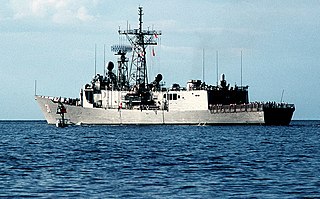
USS Stark (FFG-31) was the 23rd ship of the Oliver Hazard Perry class of guided-missile frigates and was named after Admiral Harold Rainsford Stark (1880–1972). Ordered from Todd Pacific Shipyards in Seattle, Washington, on 23 January 1978, Stark was laid down on 24 August 1979, launched on 30 May 1980, and commissioned on 23 October 1982. In 1987, an Iraqi jet fired two missiles at Stark, killing 37 U.S. sailors on board. Decommissioned on 7 May 1999, Stark was scrapped in 2006.
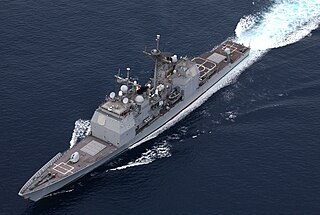
The Aegis Combat System is an American integrated naval weapons system, which uses computers and radars to track and guide weapons to destroy enemy targets. It was developed by the Missile and Surface Radar Division of RCA, and it is now produced by Lockheed Martin.

The Goalkeeper CIWS is a Dutch close-in weapon system (SEE-wiz) introduced in 1979. It is an autonomous and completely automatic weapon system for short-range defence of ships against highly maneuverable missiles, aircraft and fast-maneuvering surface vessels. Once activated the system automatically undertakes the entire air defence process from surveillance and detection to destruction, including the selection of the next priority target.

Starstreak is a British short-range surface-to-air missile that can be used as a man-portable air-defence system (MANPADS) or used in heavier systems. It is manufactured by Thales Air Defence in Belfast, Northern Ireland. It is also known as Starstreak HVM. After launch, the missile accelerates to more than Mach 4, making it the fastest short-range surface-to-air missile in existence. It then launches three laser beam-riding submunitions, increasing the likelihood of a successful hit on the target. Starstreak has been in service with the British Army since 1997. In 2012 Thales relaunched the system as ForceSHIELD.

The RIM-7 Sea Sparrow is a U.S. ship-borne short-range anti-aircraft and anti-missile weapon system, primarily intended for defense against anti-ship missiles. The system was developed in the early 1960s from the AIM-7 Sparrow air-to-air missile as a lightweight "point-defense" weapon that could be retrofitted to existing ships as quickly as possible, often in place of existing gun-based anti-aircraft weapons. In this incarnation, it was a very simple system guided by a manually aimed radar illuminator.

The Delhi-class destroyers are guided-missile destroyers of the Indian Navy. Three ships of this class are in active service. The Delhi-class vessels were the largest vessels to be built in India at the time of their commissioning. The ships were built by Mazagon Dock Limited (MDL) at a cost of ₹750 crore each.
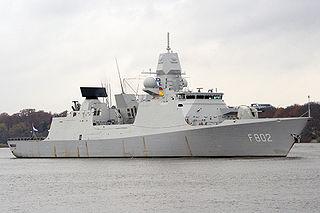
HNLMS De Zeven Provinciën (F802) is the first ship of the De Zeven Provinciën-class air defence and command frigates in service with the Royal Netherlands Navy (RNLN). There are three other ships in this class, HNLMS Tromp, HNLMS De Ruyter, and HNLMS Evertsen. De Zeven Provinciën is the eighth ship in the Royal Netherlands Navy to carry this name. The name refers to the original seven Dutch provinces which together formed the Union of Utrecht.

The RIM-162 Evolved SeaSparrow Missile (ESSM) is a development of the RIM-7 Sea Sparrow missile used to protect ships from attacking missiles and aircraft. ESSM is designed to counter supersonic maneuvering anti-ship missiles. ESSM also has the ability to be "quad-packed" in the Mark 41 Vertical Launch System, allowing up to four ESSMs to be carried in a single cell.

The Crotale is a French, all-weather, short-range surface-to-air missile system developed to intercept airborne ranged weapons and aircraft, from cruise or anti-ship missiles to helicopters, UAVs or low-flying high-performance fighter aircraft. It was developed by Thomson CSF Matra and consists of a mobile land-based variant as well as various naval ones.

The AN/SPG-51 is an American tracking / illumination fire-control radar for RIM-24 Tartar and RIM-66 Standard missiles. It is used for target tracking and Surface-to-air missile guidance as part of the Mk. 73 gun and missile director system, which is part of the Tartar Guided Missile Fire Control System.
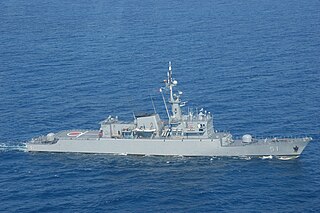
The Almirante Padilla-class frigates is a series of frigates operated by the Colombian Navy. The designation of this class is Type FS 1500 and there are four ships in service. The ships were built by Howaldtswerke-Deutsche Werft (HDW) at Kiel, West Germany in the 1980s, with the first vessel commissioning in 1983 and the last in 1984. The frigates have undergone significant modification over their careers with the 2012 Orion Program Upgrade significantly modernising the vessels. Two similar ships operate as the Kasturi-class corvettes in the Royal Malaysian Navy.

Chungmugong Yi Sun-sin class destroyers are multipurpose destroyers of the Republic of Korea Navy. The lead ship of this class, ROKS Chungmugong Yi Sunsin, was launched in May 2002 and commissioned in December 2003. Chungmugong Yi Sun-sin-class destroyers were the second class of ships to be produced in the Republic of Korea Navy's destroyer mass-production program named Korean Destroyer eXperimental, which paved the way for the navy to become a blue-water navy. Six ships were launched by Hyundai Heavy Industries and Daewoo Shipbuilding & Marine Engineering in four years.
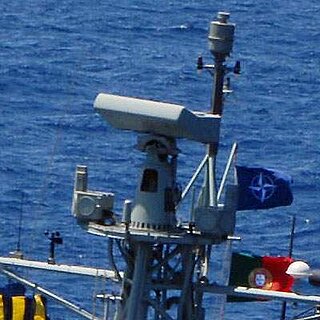
Thales Naval Nederland MW08 is a G-band passive electronically scanned array target indication 3D radar, part of the 3D multibeam 'SMART' family which includes E/F band SMART-S/SMART-S Mk2 and D band SMART-L.
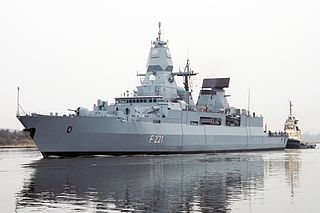
The F124 Sachsen class is the German Navy's latest class of highly advanced air-defense frigates. The design of the Sachsen-class frigate is based on that of the F123 Brandenburg class but with enhanced stealth features designed to deceive an opponent's radar and acoustic sensors. The class incorporates an advanced multifunction radar APAR and a SMART-L long-range radar which is purported to be capable of detecting stealth aircraft and stealth missiles.
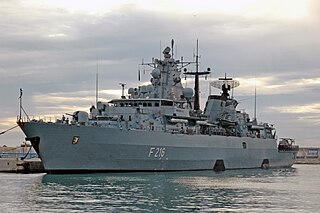
The F123 Brandenburg class is a class of German frigate. They were ordered by the German Navy in June 1989 and completed and commissioned between 1994 and 1996, replacing the Hamburg-class destroyers. The ships primarily carry out anti-submarine warfare (ASW), but they also contribute to local anti-aircraft defenses, the tactical command of squadrons, and surface-to-surface warfare operations. Together with the F124 Sachsen-class frigates, they are the mainstay of the German surface fleet.

The Tartar Guided Missile Fire Control System is an air defense system developed by the United States Navy to defend warships from air attack. Since its introduction the system has been improved and sold to several United States allies.
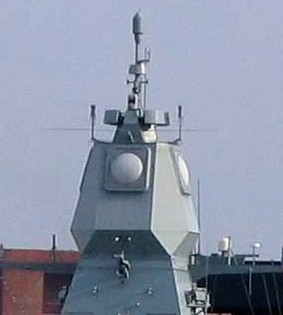
Active Phased Array Radar (APAR) is a shipborne active electronically scanned array multifunction 3D radar (MFR) developed and manufactured by Thales Nederland. The radar receiver modules are developed and built in the US by the Sanmina Corporation.

The RIM-66 Standard MR (SM-1MR/SM-2MR) is a medium-range surface-to-air missile (SAM), with a secondary role as an anti-ship missile, developed for the United States Navy (USN). A member of the Standard Missile family of weapons, the SM-1 was developed as a replacement for the RIM-2 Terrier and RIM-24 Tartar that were deployed in the 1950s on a variety of USN ships. The RIM-67 Standard (SM-1ER/SM-2ER) is an extended range version of this missile with a solid rocket booster stage.

The Mark 92 Fire Control System is a US-built medium-range anti-aircraft missile and gun fire control system. It was developed for the FFG-7 Oliver Hazard Perry class guided missile frigates. The system is a licensed USN version of the Thales Nederland WM-25 fire control system. The Mark 92 fire control system was approved for service use in 1975. Introduction to the fleet and follow-on test and evaluation began in 1978.

Type 81 Fire Control System (FCS-2) is a Japanese shipboard gun and missile fire-control system. This series of systems has been installed on destroyers of the Japan Maritime Self-Defense Force built between FY1977 and FY2001 to control medium-caliber guns and Sea Sparrow missiles, including ESSM.


















